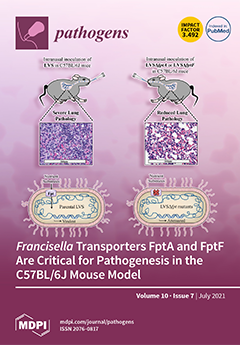Aliarcobacter butzleri is an emergent enteropathogen, showing high genetic diversity, which likely contributes to its adaptive capacity to different environments. Whether natural transformation can be a mechanism that generates genetic diversity in
A. butzleri is still unknown. In the present study, we aimed
[...] Read more.
Aliarcobacter butzleri is an emergent enteropathogen, showing high genetic diversity, which likely contributes to its adaptive capacity to different environments. Whether natural transformation can be a mechanism that generates genetic diversity in
A. butzleri is still unknown. In the present study, we aimed to establish if
A. butzleri is naturally competent for transformation and to investigate the factors influencing this process. Two different transformation procedures were tested using exogenous and isogenic DNA containing antibiotic resistance markers, and different external conditions influencing the process were evaluated. The highest number of transformable
A. butzleri strains were obtained with the agar transformation method when compared to the biphasic system (65% versus 47%).
A. butzleri was able to uptake isogenic chromosomal DNA at different growth phases, and the competence state was maintained from the exponential to the stationary phases. Overall, the optimal conditions for transformation with the biphasic system were the use of 1 μg of isogenic DNA and incubation at 30 °C under a microaerobic atmosphere, resulting in a transformation frequency ~8 × 10
−6 transformants/CFU. We also observed that
A. butzleri favored the transformation with the genetic material of its own strain/species, with the DNA incorporation process occurring promptly after the addition of genomic material. In addition, we observed that
A. butzleri strains could exchange genetic material in co-culture assays. The presence of homologs of well-known genes involved in the competence in the
A. butzleri genome corroborates the natural competence of this species. In conclusion, our results show that
A. butzleri is a naturally transformable species, suggesting that horizontal gene transfer mediated by natural transformation is one of the processes contributing to its genetic diversity. In addition, natural transformation can be used as a tool for genetic studies of this species.
Full article






